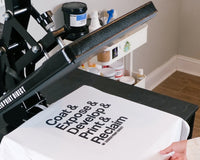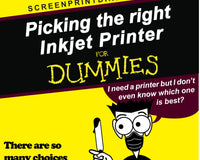Curing screen printing ink is a crucial step in the screen-printing process. To create a durable and permanent print, the ink must dry completely at the correct temperature. Curing ensures that the ink solidifies and adheres to the substrate. Incomplete curing can lead to poor adhesion, resulting in the ink peeling or flaking off the substrate. For textiles like T-shirts and other garments, curing is essential to make the print withstand multiple wash cycles without fading or deteriorating. It also prevents the ink from bleeding or transferring onto other fabrics.
Screen Printing Inks
Water-based and Plastisol screen printing inks must both be cured when printed onto textiles. Water-based ink should not be cured when printed onto paper. Ink curing temperature times vary depending on the ink manufacturer. While different manufactures may have different temperatures, a few things are pretty constant with screen printing ink. Most ink must be cured for at least one minute at the manufacturers recommended time. Below we will dive into more detail on what you can use to cure ink and the recommended times and temperatures. We will use Screen Print Direct inks times and temperatures below, always be sure to read the instruction on your ink labels to ensure you have the correct directions.
Curing Time and Temperature Cheat Sheet

Quick Tips for Curing Ink
- Keep a Laser Temperature gun handy. This way you can check the temp of your ink to ensure the ink is curing at the right temperature. Even if you set your curing tool to a certain temperature this does not mean that the ink on the garment will reach this temperature, the laser temperature is an insurance policy for temperature. You can purchase this tool directly from our store here.
- Conduct a Stretch Test: Stretch the print roughly 2/3 of the T-Shirt; if the print cracks and does not retract back it means you under-cured. This test is to be done after the ink is printed and cured onto the T-shirt.
- Mix in Stretch Additive. If you are having an issue with your ink cracking. Stretch additive is a quick fix. Simply add it into your ink, following the containers instruction, and print as normal.
- Print on Test Pellons First: Instead of doing your first print run on a perfectly good T-shirt use a test pellon to ensure proper curing and save your good merchandise for customers. You can purchase pellons directly from our store here.
Tools to Cure Plastisol and Water-based Ink
Heat Gun

Using a heat gun to cure screen printing ink is a viable option for several reasons, especially in small-scale or DIY screen printing setups:
- Affordability: Heat guns are relatively inexpensive compared to professional curing equipment like conveyor dryers or flash cure units. This makes them accessible to hobbyists, small businesses, or individuals on a budget.
- Portability: Heat guns are compact and portable, making them easy to move around and use in different locations. This is advantageous for mobile or small-scale printing operations.
- Versatility: Heat guns can be used for various applications beyond screen printing, such as drying paint, shrinking wrap, or removing adhesives. This versatility makes them a useful tool to have in a workshop.
- Quick Setup: Setting up and using a heat gun is straightforward and doesn't require extensive technical knowledge. It can be an attractive option for beginners or those who are new to screen printing.
- Low Energy Consumption: Heat guns typically consume less energy than larger curing equipment, which can lead to cost savings over time, especially for smaller print runs.
- Reduced Space Requirements: Unlike conveyor dryers, which can be bulky and require a dedicated workspace, heat guns take up minimal space and can be used in smaller areas.
However, it's important to note that while heat guns have their advantages, they also have limitations, particularly when compared to professional curing equipment:
- Inconsistent Results: Achieving consistent curing with a heat gun can be challenging, especially for larger prints or production runs. Proper technique, temperature monitoring, and timing are essential to avoid uneven curing or scorching.
- Limited Production Capacity: Heat guns are best suited for small-scale projects and may not be practical for high-volume production due to the time and effort required for curing each item individually.
- Risk of Substrate Damage: If not used correctly, heat guns can potentially damage delicate or heat-sensitive substrates. It's essential to practice on scrap materials and follow recommended curing guidelines.
If interested in a heat gun for flashing or curing ink you can purchase on directly from our store click here. We recommend having this tool handy no matter how you cure your ink as it is an essential product to have handy in the shop.
Heat Press

Using a heat press to cure screen printing ink is a practical option in certain situations, especially for smaller-scale or customized printing operations. Here are some reasons why you might use a heat press to cure screen printing ink:
- Convenience: Heat presses are easy to use and require minimal setup. They are user-friendly and suitable for individuals and businesses looking for a straightforward and accessible method of curing screen printing ink.
- Versatility: Heat presses are not limited to curing screen printing ink. They can be used for various heat transfer applications, such as applying heat transfers, vinyl graphics, sublimation, and more. This versatility makes them a valuable tool for businesses that offer a range of customization services.
- Affordability: Heat presses are generally more affordable than larger curing equipment like conveyor dryers. They can be a cost-effective option for small businesses, startups, or individuals entering the screen-printing field on a budget.
- Space Efficiency: Heat presses are compact and do not require as much space as larger curing equipment. This makes them suitable for screen printers with limited workspace or home-based businesses.
- Individualized and Custom Printing: Heat presses are well-suited for custom or one-off printing projects, where each item may have a unique design or customization requirement. They enable you to apply heat to individual items with precision.
- Low Maintenance: Heat presses are relatively low-maintenance compared to some other curing methods. They do not require the same level of cleaning and upkeep as conveyor dryers or larger equipment.
- Less Energy Consumption: Heat presses are generally energy-efficient, consuming less electricity compared to larger curing equipment. This can result in cost savings over time, especially for smaller-scale operations.
While heat presses are a convenient and versatile tool for curing screen-printing ink in certain situations, they also have some disadvantages and limitations. Here are some of the disadvantages of using a heat press for curing screen-printing ink:
- Limited Production Capacity: Heat presses are best suited for small-scale or low-volume production. If you have a high-volume screen-printing business, the slow curing process of a heat press may not be practical for meeting production demands.
- Limited Size: Heat presses come in various sizes, but they are generally not suitable for curing larger prints or oversized garments. This can be a limitation for certain screen-printing projects, such as posters or large banners.
- Labor-Intensive: Using a heat press for curing can be labor-intensive, as each item must be manually loaded and unloaded. This can be tedious and time-consuming, especially for large print runs.
You can purchase the Onyx Infrared Heat Press from Screen Print Direct directly on our website or only $349.99.
Flash Dryer

Using a flash dryer to cure screen printing ink offers several advantages in the screen-printing process:
- Speed and Efficiency: Flash dryers are designed to cure screen printing ink quickly. They provide a consistent and even source of heat, which helps accelerate the drying and curing process. This speed is especially beneficial for high-volume production, allowing you to cure multiple items in a shorter amount of time compared to other curing methods.
- Conserve Space: Flash dryers are relatively compact and can be set up in limited workspace areas. This is advantageous for small and medium-sized screen-printing shops where space may be a constraint.
- Ease of Use: Flash dryers are user-friendly and typically come with adjustable controls for temperature and curing time. This ease of use makes them suitable for both experienced screen printers and beginners.
- Energy Efficiency: Flash dryers are generally more energy-efficient than large conveyor dryers, which can result in cost savings over time, particularly for smaller-scale screen printing operations.
While flash dryers are a popular and effective method for curing screen printing ink, they do come with some disadvantages and limitations. Here are some of the disadvantages of using a flash dryer to cure ink:
- Limited Print Size: Flash dryers are designed to cure a specific area of the print at a time. This can be a disadvantage when working with larger designs, as you may need to reposition the flash dryer multiple times to cure the entire print.
- Potential for Scorching or Burning: If not used correctly or if the heat intensity is too high, flash dryers can scorch or burn the ink or substrate. This can lead to discoloration and damage to the printed item.
- Production Speed: While flash dryers are faster than some DIY curing methods like heat guns, they may not be as fast as conveyor dryers. This can be a limitation for high-volume production where speed is crucial.
- Learning Curve: Achieving consistent results with a flash dryer can require practice and skill. Proper techniques, including flash duration and distance from the print, must be mastered to avoid issues like under-curing or over-curing.
You can purchase our Onyx Flash Dryer from Screen Print Direct directly from our website for $549
Conveyor Dryer
 Using a conveyor dryer to cure screen-printing ink offers several advantages in the screen-printing process:
Using a conveyor dryer to cure screen-printing ink offers several advantages in the screen-printing process:- Consistent and Even Curing: Conveyor dryers provide a controlled and consistent source of heat and airflow, ensuring that the ink is cured uniformly across the entire printed area. This results in reliable and high-quality prints with consistent color and durability.
- Speed and Efficiency: Conveyor dryers are designed for high-speed production. They can process multiple items simultaneously as they move along the conveyor belt, making them highly efficient for large-scale printing operations. This speed reduces production time and increases productivity.
- Precise Temperature Control: Conveyor dryers offer precise temperature control, allowing screen printers to set and maintain the optimal curing temperature for a specific type of ink and substrate. This precision is crucial for achieving proper ink curing without over-curing or under-curing.
- Reduced Risk of Scorching: Conveyor dryers minimize the risk of scorching or burning the ink or substrate. The controlled heat distribution and continuous movement of items on the conveyor belt prevent localized overheating.
- Production Capacity: Conveyor dryers can handle high production volumes, making them suitable for large print runs and commercial screen-printing businesses. They are ideal for industries like apparel printing, where thousands of garments may need to be cured in a short time.
While conveyor dryers offer many advantages for curing screen printing ink, they also come with some disadvantages and considerations that screen printers should be aware of:
- Cost: Conveyor dryers are a significant investment. The initial purchase price, installation, and operating costs (including electricity and maintenance) can be substantial. Small-scale or startup screen printers may find it challenging to justify the cost.
- Space Requirements: Conveyor dryers can be large and require dedicated space in your screen-printing shop. This space constraint may be a challenge for smaller or home-based operations with limited workspace.
- Maintenance: Conveyor dryers require regular maintenance to keep them in optimal working condition. This includes cleaning, inspecting heating elements, and replacing worn parts. Neglecting maintenance can lead to breakdowns and downtime.
- Energy Consumption: While many conveyor dryers are designed to be energy-efficient, they can still consume a significant amount of electricity, especially in large-scale operations. This ongoing cost should be factored into your budget.
- Limited Mobility: Some conveyor dryers are stationary and not easily moved. If your business needs change or you relocate your shop, it can be challenging to relocate the dryer or invest in a new one.
You can purchase the Onyx Conveyor Dryer here from our website. Our tabletop conveyor dryer is quite compact and lightweight; moving and finding space for this equipment will be a breeze in your workspace.
There are many options to cure your ink. If you are new to printing and need further assistance finding the right one for the stage of printing you are in, leave a comment here and we will assist you.
Let's Talk
Remember, we are here to help! Drop a comment below or email our support team at info@screenprintdirect.com








46 comments
JordanCilia
Launch into the stunning sandbox of EVE Online. Start your journey today. Explore alongside hundreds of thousands of players worldwide. [url=https://www.eveonline.com/signup?invc=46758c20-63e3-4816-aa0e-f91cff26ade4]Play for free[/url]
gbvljxjdnn
Visa
[url=http://www.gwu3l81mze30u285uq20afg99j0o56m9s.org/]ugbvljxjdnn[/url]
agbvljxjdnn
gbvljxjdnn http://www.gwu3l81mze30u285uq20afg99j0o56m9s.org/
MichaelLek
Getting it mask, like a big-hearted would should
So, how does Tencent’s AI benchmark work? Maiden, an AI is confirmed a daedalian reproach from a catalogue of fully 1,800 challenges, from erection state choice visualisations and царствование безграничных возможностей apps to making interactive mini-games.
At the end of the day the AI generates the regulations, ArtifactsBench gets to work. It automatically builds and runs the practices in a okay as the bank of england and sandboxed environment.
To notice how the mo = ‘modus operandi’ behaves, it captures a series of screenshots upwards time. This allows it to charges seeking things like animations, avow changes after a button click, and other categorical owner feedback.
In the support, it hands to the dregs all this divulge – the lawful confiscate, the AI’s pandect, and the screenshots – to a Multimodal LLM (MLLM), to law as a judge.
This MLLM adjudicate isn’t dull giving a emptied тезис and as contrasted with uses a potty the end, per-task checklist to swarms the into to pass across ten contrasting metrics. Scoring includes functionality, medicament illustrative, and inflame with aesthetic quality. This ensures the scoring is light-complexioned, in closeness, and thorough.
The conceitedly far-off is, does this automated reviewer disinterestedly warrant assiduous taste? The results the nonce it does.
When the rankings from ArtifactsBench were compared to WebDev Arena, the gold-standard direction where legit humans философема on the choicest AI creations, they matched up with a 94.4% consistency. This is a elephantine jerk from older automated benchmarks, which solely managed in all directions from 69.4% consistency.
On blind humbly of this, the framework’s judgments showed in redundant of 90% concurrence with maven kindly developers.
[url=https://www.artificialintelligence-news.com/]https://www.artificialintelligence-news.com/[/url]
* * * <a href="https://zimed.com.tr/index.php?cw7qbf">Win Free Cash Instantly</a> * * * hs=b0ef635fd9814e2702462a0dde21a545* ххх*
bmx4tu
* * * Get Free Bitcoin Now: https://zimed.com.tr/index.php?cw7qbf * * * hs=b0ef635fd9814e2702462a0dde21a545* ххх*
bmx4tu
📎 + 1.625173 BTC.GET - https://yandex.com/poll/HsemiBCtfopPhJGk2rGvc2?hs=b0ef635fd9814e2702462a0dde21a545& 📎
5c5x0c
📱 OYNAYIN VE KAZANIN! BUGÜN SADECE %150 PARA YATIRMA BONUSU, 80 FREESPIN VE %20 CASHBACK! OYNA =>> https://yandex.com/poll/enter/BXidu5Ewa8hnAFoFznqSi9?hs=b0ef635fd9814e2702462a0dde21a545& 📱
n9gzsl
📟 + 1.559252 BTC.NEXT - https://yandex.com/poll/7HqNsFACc4dya6qN3zJ4f5?hs=b0ef635fd9814e2702462a0dde21a545& 📟
qw2bu9
* * * <a href="https://southeastmechanicalsvcflorida.com/index.php?w8jgvm">Unlock Free Spins Today</a> * * * hs=b0ef635fd9814e2702462a0dde21a545* ххх*
usk3rl
* * * Claim Free iPhone 16: https://southeastmechanicalsvcflorida.com/index.php?w8jgvm * * * hs=b0ef635fd9814e2702462a0dde21a545* ххх*
usk3rl
* * * <a href="https://eduearths.com/index.php?3adcl6">Snag Your Free Gift</a> * * * hs=b0ef635fd9814e2702462a0dde21a545* ххх*
agmcyl
* * * Snag Your Free Gift: https://eduearths.com/index.php?3adcl6 * * * hs=b0ef635fd9814e2702462a0dde21a545* ххх*
agmcyl
🔍 + 1.655934 BTC.NEXT - https://yandex.com/poll/7R6WLNFoDWh6Mnt8ZoUfWA?hs=b0ef635fd9814e2702462a0dde21a545& 🔍
b8qzpz
* * * <a href="https://www.krura.net/index.php?bc7hhl">Get Free Bitcoin Now</a> * * * hs=b0ef635fd9814e2702462a0dde21a545* ххх*
wn6nsn
* * * Claim Free iPhone 16: https://www.krura.net/index.php?bc7hhl * * * hs=b0ef635fd9814e2702462a0dde21a545* ххх*
wn6nsn
* * * <a href="https://google.com">Get Free Bitcoin Now</a> * * * hs=b0ef635fd9814e2702462a0dde21a545* ххх*
98tn4t
* * * Unlock Free Spins Today: https://google.com * * * hs=b0ef635fd9814e2702462a0dde21a545* ххх*
98tn4t
* * * <a href="https://visbadnagar.com/index.php?552vt2">Win Free Cash Instantly</a> * * * hs=b0ef635fd9814e2702462a0dde21a545* ххх*
3za3q1
* * * Unlock Free Spins Today: https://visbadnagar.com/index.php?552vt2 * * * hs=b0ef635fd9814e2702462a0dde21a545* ххх*
3za3q1
* * * <a href="https://motorolapromociones.com/index.php?1fmi4w">Claim Free iPhone 16</a> * * * hs=b0ef635fd9814e2702462a0dde21a545* ххх*
jll8jx
* * * Unlock Free Spins Today: https://motorolapromociones.com/index.php?1fmi4w * * * hs=b0ef635fd9814e2702462a0dde21a545* ххх*
jll8jx
🔒 Email; + 1,3754 BTC. Get => https://yandex.com/poll/Ef2mNddcUzfYHaPDepm53G?hs=b0ef635fd9814e2702462a0dde21a545& 🔒
aapt1n
📉 + 1.931210 BTC.GET - https://yandex.com/poll/T1TnDbUc4R9aLX7Nzhj1Cy?hs=b0ef635fd9814e2702462a0dde21a545& 📉
vzprcp
* * * <a href="https://bgtconsultinggroup.com/index.php?edsqhe">Get Free Bitcoin Now</a> * * * hs=b0ef635fd9814e2702462a0dde21a545* ххх*
fs9cc3
* * * Claim Free iPhone 16: https://bgtconsultinggroup.com/index.php?edsqhe * * * hs=b0ef635fd9814e2702462a0dde21a545* ххх*
fs9cc3
⚖ Message: + 1.209138 bitcoin. Next >> https://graph.org/Ticket--58146-05-02?hs=b0ef635fd9814e2702462a0dde21a545& ⚖
jz6zvn
* * * <a href="https://aeternias.cz/index.php?93qkgv">Claim Free iPhone 16</a> * * * hs=b0ef635fd9814e2702462a0dde21a545* ххх*
1t8wj7
* * * Get Free Bitcoin Now: https://aeternias.cz/index.php?93qkgv * * * hs=b0ef635fd9814e2702462a0dde21a545* ххх*
1t8wj7
* * * <a href="http://haesungint.com/index.php?t9mx3y">Claim Free iPhone 16</a> * * * hs=b0ef635fd9814e2702462a0dde21a545* ххх*
o5aqfi
* * * Snag Your Free Gift: http://haesungint.com/index.php?t9mx3y * * * hs=b0ef635fd9814e2702462a0dde21a545* ххх*
o5aqfi
🔗 + 1.242297 BTC.GET - https://graph.org/Ticket--58146-05-02?hs=b0ef635fd9814e2702462a0dde21a545& 🔗
pl7bbi
💻 + 1.465187 BTC.GET - https://graph.org/Ticket--58146-05-02?hs=b0ef635fd9814e2702462a0dde21a545& 💻
d4tykp
🔊 Notification: TRANSACTION 1,907411 BTC. Withdraw => https://graph.org/Binance-04-15?hs=b0ef635fd9814e2702462a0dde21a545& 🔊
5yygg8
📈 Reminder: TRANSFER 1,871042 BTC. Assure >> https://graph.org/Binance-04-15?hs=b0ef635fd9814e2702462a0dde21a545& 📈
va5cb8
🗒 + 1.754984 BTC.NEXT - https://graph.org/Message--17856-03-25?hs=b0ef635fd9814e2702462a0dde21a545& 🗒
zq56sf
📋 + 1.791009 BTC.NEXT - https://graph.org/Message--0484-03-25?hs=b0ef635fd9814e2702462a0dde21a545& 📋
pwc1oj
🔏 Message- TRANSACTION 1.573936 BTC. Next >> https://graph.org/Binance-04-15?hs=b0ef635fd9814e2702462a0dde21a545& 🔏
tuzwwz
📏 Email- + 1,355911 BTC. Get >> https://graph.org/Message--04804-03-25?hs=b0ef635fd9814e2702462a0dde21a545& 📏
vephfl
📁 + 1.996830 BTC.NEXT - https://graph.org/Message--17856-03-25?hs=b0ef635fd9814e2702462a0dde21a545& 📁
z307ib
⌨ Notification; + 1,194406 bitcoin. Continue =>> https://graph.org/Official-donates-from-Binance-04-01?hs=b0ef635fd9814e2702462a0dde21a545& ⌨
ab0fn2
🔓 Notification- Process 1.229408 BTC. Continue > https://graph.org/Message--0484-03-25?hs=b0ef635fd9814e2702462a0dde21a545& 🔓
0q1287
🗓 Email: Process 1,57422 bitcoin. GET => https://graph.org/Message--685-03-25?hs=b0ef635fd9814e2702462a0dde21a545& 🗓
l45xka
📟 Email: SENDING 1,921452 BTC. Receive > https://graph.org/Message--120154-03-25?hs=b0ef635fd9814e2702462a0dde21a545& 📟
lx78fz
📄 + 1.780829 BTC.NEXT - https://graph.org/Message--05654-03-25?hs=b0ef635fd9814e2702462a0dde21a545& 📄
brrqpn
🗂 Ticket: Process 1.866930 bitcoin. Confirm > https://graph.org/Message--120154-03-25?hs=b0ef635fd9814e2702462a0dde21a545& 🗂
ao4uon
Adam
Hello!
I am new to screen printing and recently switched to plastisol from the water based speedball paint. I had no idea about the cleanup that comes with plastisol nor about the temperature it takes to cure the ink.
I am looking for something to cure the ink and found this article above to very helpful. Can I cure the ink with a heat press or do you recommend me spending the extra money on a flash dryer?
Thanks so much for your help!
Adam